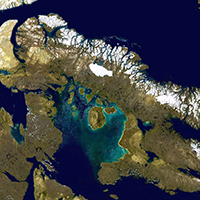Physical and chemical characteristics of 1300 lakes and ponds across the Canadian Arctic
Characteristics of Canadian Arctic lakes and ponds

Accepted: 25 August 2020
Supplementary: 107
HTML: 255
All claims expressed in this article are solely those of the authors and do not necessarily represent those of their affiliated organizations, or those of the publisher, the editors and the reviewers. Any product that may be evaluated in this article or claim that may be made by its manufacturer is not guaranteed or endorsed by the publisher.
Authors
Lakes and ponds are a major feature of the Arctic landscape and are recognized as effective ‘sentinels of change’. Here we present water chemistry characteristics of lakes and ponds (n=1300 with 26 variables) across the Canadian Arctic collated from published studies. We also extracted geological and ecoregion data in an attempt to determine the key drivers. In general, most lakes were shallow (85.4%, <10 m), nutrient (phosphorus) poor (oligotrophic = 45.6% and ultra-oligotrophic = 24.8%), located at low elevation (66.5%, <200 m asl), close to coastlines (72.5%, 0-50 km), and underlain by sedimentary geology (66.5%). The first two components from Principal Component Analysis explained 49.3% of the variation in the dataset; the first component was dominated by conductivity/carbonate materials, and the second component suggested allochthonous inputs of phosphorus. In general, bedrock geology is the primary driver of water chemistry; as such, there were major differences between lakes underlain by igneous and sedimentary rocks. Those on sedimentary bedrock tend to have higher pH, nutrients and higher inorganic ion concentrations.
Edited by
Michela Rogora, CNR-IRSA Verbania, ItalyHow to Cite
Similar Articles
- Davide A.L. Vignati, Roberta Bettinetti, Aldo Marchetto, Long-term persistence of sedimentary copper contamination in Lake Orta: potential environmental risks 20 years after liming , Journal of Limnology: Vol. 75 No. s2 (2016): Lake Orta: a new lease on life
- Xu Sun, Zhixin Hu, Wen Jia, Cuilan Duan, Liuyan Yang, Decaying cyanobacteria decrease N2O emissions related to diversity of intestinal denitrifiers of Chironomus plumosus , Journal of Limnology: Vol. 74 No. 2 (2015)
- Angela Boggero, Elzbieta Dumnicka, Riccardo Fornaroli, Daniele Paganelli, Silvia Zaupa, Geotargeting spatial and temporal data of Italian freshwater high-altitude macroinvertebrates , Journal of Limnology: Vol. 82 No. s1 (2023): Georeferenced freshwater biodiversity data
- Amanda Valois, Keith Somers, Chantal Sarrazin-Delay, Wendel (Bill) Keller, Are bioassessments based on the reference condition approach affected by rapid approaches to sample collection and processing? , Journal of Limnology: Vol. 75 No. 2 (2016)
- Hugh B. Feeley, Stephen Davis, Michael Bruen, Sean Blacklocke, Mary Kelly-Quinn, The impact of a catastrophic storm event on benthic macroinvertebrate communities in upland headwater streams and potential implications for ecological diversity and assessment of ecological status , Journal of Limnology: Vol. 71 No. 2 (2012)
- Rosario Mosello, An archive for the history of limnology in Verbania Pallanza (Northern Italy) , Journal of Limnology: Vol. 80 No. 3 (2021): Celebratory Issue - 80th Anniversary of the Journal of Limnology
- Helmi Saidi, Claudia Dresti, Marzia Ciampittiello, Fluctuations of Lake Orta water levels: preliminary analyses , Journal of Limnology: Vol. 75 No. s2 (2016): Lake Orta: a new lease on life
- Agostina Tabilio Di Camillo, Angela Boggero, Diana Maria Paola Galassi, Lyudmila Kamburska, Barbara Fiasca, Tiziana Di Lorenzo, Dataset of benthic copepods in the littoral zones of Lake Maggiore , Journal of Limnology: Vol. 81 No. s2 (2022): Effects of water level management on lake littorals and downstream river areas
- Silvia Marková, Catia Maurone, Erica Racchetti, Marco Bartoli, Valeria Rossi, Daphnia diversity in water bodies of the Po River Basin , Journal of Limnology: Vol. 76 No. 2 (2017)
- Long Ma, Jinglu Wu, Wen Liu, Jilili Abuduwaili, Distinguishing between anthropogenic and climatic impacts on lake size: a modeling approach using data from Ebinur Lake in arid northwest China , Journal of Limnology: Vol. 73 No. 2 (2014)
<< < 24 25 26 27 28 29 30 31 32 33 > >>
You may also start an advanced similarity search for this article.
-
Jonathan B. Martin, Andrea J. Pain, Ellen E. Martin
-
Zhizhong Li, Madjid Hadioui, Kevin J. WilkinsonNanomaterials : 2023

 https://doi.org/10.4081/jlimnol.2020.1973
https://doi.org/10.4081/jlimnol.2020.1973





